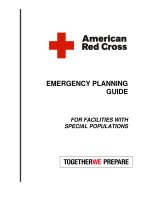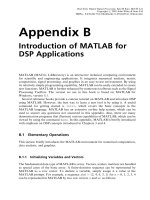COMPUTED TOMOGRAPHY – SPECIAL APPLICATIONS docx
Bạn đang xem bản rút gọn của tài liệu. Xem và tải ngay bản đầy đủ của tài liệu tại đây (46.46 MB, 328 trang )
COMPUTED TOMOGRAPHY
– SPECIAL APPLICATIONS
Edited by Luca Saba
Computed Tomography – Special Applications
Edited by Luca Saba
Published by InTech
Janeza Trdine 9, 51000 Rijeka, Croatia
Copyright © 2011 InTech
All chapters are Open Access distributed under the Creative Commons Attribution 3.0
license, which permits to copy, distribute, transmit, and adapt the work in any medium,
so long as the original work is properly cited. After this work has been published by
InTech, authors have the right to republish it, in whole or part, in any publication of
which they are the author, and to make other personal use of the work. Any republication,
referencing or personal use of the work must explicitly identify the original source.
As for readers, this license allows users to download, copy and build upon published
chapters even for commercial purposes, as long as the author and publisher are properly
credited, which ensures maximum dissemination and a wider impact of our publications.
Notice
Statements and opinions expressed in the chapters are these of the individual contributors
and not necessarily those of the editors or publisher. No responsibility is accepted for the
accuracy of information contained in the published chapters. The publisher assumes no
responsibility for any damage or injury to persons or property arising out of the use of any
materials, instructions, methods or ideas contained in the book.
Publishing Process Manager Masa Vidovic
Technical Editor Teodora Smiljanic
Cover Designer Jan Hyrat
Image Copyright Daniela Illing, 2011. Used under license from Shutterstock.com
First published October, 2011
Printed in Croatia
A free online edition of this book is available at www.intechopen.com
Additional hard copies can be obtained from
Computed Tomography – Special Applications, Edited by Luca Saba
p. cm.
ISBN 978-953-307-723-9
free online editions of InTech
Books and Journals can be found at
www.intechopen.com
Contents
Preface IX
Part 1 Non-Radiological Application 1
Chapter 1 Application of CT for the Study of Pathology of the Jaws 3
Tatsurou Tanaka, Yasuhiro Morimoto, Tatsurou Tanaka,
Shinji Kito, Ayataka Ishikawa, Shinya Kokuryo,
Noriaki Yamamoto, Manabu Habu, Ikuya Miyamoto, Masaaki
Kodama, Shinobu Matsumoto-Takeda, Masafumi Oda,
Nao Wakasugi-Sato, Kozue Otsuka, Shunji Shiiba,
Yuji Seta, Yoshihiro Yamashita, Izumi Yoshioka,
Kou Matsuo, Tetsu Takahashi, Kazuhiro Tominaga
and Yasuhiro Morimoto
Chapter 2 Estimated Specific Gravity with Quantitative
CT Scan in Traumatic Brain Injury 25
Vincent Degos, Thomas Lescot and Louis Puybasset
Chapter 3 The Locally Adapted Scaling Vector Method: A New Tool for
Quantifying Anisotropic Structures in Bone Images 37
Roberto Monetti, Jan Bauer, Thomas Baum, Irina Sidorenko,
Dirk Müller, Felix Eckstein, Thomas Link
and Christoph Räth
Chapter 4 CT Scanning in Archaeology 57
Stephen Hughes
Chapter 5 Adrenal Imaging Methods : Comparison of Mean CT
Attenuation, CT Histogram Analysis and Chemical
Shift Magnetic Resonance Imaging for Adrenal Mass
Characterization and Review of the Literature 71
Ahmet Mesrur Halefoglu
Chapter 6 CT-Guided Brachytherapy Planning 105
Cem Onal and Ezgi Oymak
VI Contents
Part 2 General Science Application 121
Chapter 7 Gas Trapping During Foamed Flow in Porous Media 123
Quoc P. Nguyen
Chapter 8 X-Ray Fluorescence Microtomography
in Biological Applications 153
Gabriela R. Pereira and Ricardo T. Lopes
Chapter 9 3D-μCT Cephalometric Measurements in Mice 169
F. de Carlos, A. Alvarez-Suárez, S. Costilla,
I. Noval, J. A. Vega and J. Cobo
Chapter 10 Effect of Buoyancy on Pore-Scale Characteristics of
Two-Phase Flow in Porous Media 179
Tetsuya Suekane and Hiroki Ushita
Chapter 11 Conventional - and Cone Beam – CT - Derived
Stereolithographic Surgical Guides in the Planning
and Placement of Dental Implants 195
Volkan Arısan
Chapter 12 Differential Cone-Beam CT
Reconstruction for Planar Objects 217
Liu Tong
Chapter 13 Cross-Sectional Imaging in Comparative Vertebrate
Morphology - The Intracranial Joint of the
Coelacanth Latimeria chalumnae 259
Peter Johnston
Chapter 14 Scaling Index Method (SIM): A Novel Technique
for Assessment of Local Topological Properties of
Porous and Irregular Structures 275
Irina Sidorenko, Roberto Monetti, Jan Bauer,
Dirk Müller and Christoph Räth
Chapter 15 Gamma-Ray Computed Tomography in
Soil Science: Some Applications 293
Luiz Fernando Pires, Fábio Augusto Meira Cássaro,
Osny Oliveira Santos Bacchi and Klaus Reichardt
Preface
It is my pleasure to present the book titled “Computed Tomography - Special
Applications”. Computed tomography (CT) and in particular multi-detector-row
computed tomography (MDCT), is a powerful non-invasive imaging tool with a
number of advantages over the other non-invasive imaging techniques.
CT has evolved into an indispensable imaging method in clinical routine. It was the
first method to non-invasively acquire images of the inside of the human body that
were not biased by superimposition of distinct anatomical structures.
The first generation of CT scanners developed in the 1970s and numerous innovations
have improved the utility and application field of the CT, such as the introduction of
helical systems that allowed the development of the “volumetric CT” concept.
A further major improvement in CT technology is the incorporation of multiple-
detector row longitudinally (along the z-axis) in the gantry. In 1998 the first 4-detector
row scanner was proposedand since then 16-32-64-128 and 320 detector row units
have been introduced. A recent major improvement in CT technology is the
introduction of the dual source CT that promises exceptional potentialities in tissue
analysis and characterization. Isotropic voxels, high spatial and temporal resolution,
use of fast contrast material injection rate and post-processing tools improved
sensitivity and specificity of this technology in solving diagnostic medical problems.
The purpose of this publication is to explore the applications of CT from medical
imaging to other fields like physics, archaeology ad computer aided diagnosis. Recently
interesting technical, anthropomorphic, forensic and archeological as well as
paleontological applications of computed tomography have been developed. These
applications further strengthen the method as a generic diagnostic tool for non
destructive material testing and three dimensional visualization beyond its medical use.
Luca Saba MD
Department of Science of the Images
Policlinico Universitario
University of Cagliari
Italy
Part 1
Non-Radiological Application
1
Application of CT for the Study of
Pathology of the Jaws
Tatsurou Tanaka et al.
*
Department of Oral Diagnostic Science, Kyushu Dental College, Kitakyushu
Japan
1. Introduction
Computed tomography (CT) scanning is very useful in identifying and evaluating the
location, size, and suspected pathological diagnosis of lesions such as cysts, tumors, and
infections. At the same time, it aids in the elucidation of bone and surrounding soft tissue
invasion of lesions with high resolution.
1, 2
In the maxilla and mandible, teeth are included
and the CT capacity there can distinguished a foreign body of only 30 µm. Precise size and
location are needed in the evaluation of lesions in the maxilla and mandible based on a high
resolution in addition to the suspected pathological diagnosis based on CT findings.
Therefore, multi-detector CT (MDCT) scanning is commonly applied for various kinds of
lesions in the maxilla and mandible because of its precision and diagnostic accuracy. Multi-
detector CT scanning provides rapid acquisition of numerous thin axial images and more
accurate reconstruction images. Multi-detector CT scanning provides accurate information
about the height, width, and three-dimensional (3D) evaluation of the maxilla and mandible,
as well as detailed information about the location of normal anatomical structures, such as
the mandibular canal, mental foramen, mandibular foramen, incisive foramen, and
maxillary sinus. In addition, the relationship between lesions and anatomical landmarks,
including cortical margins and roots of teeth, can be established. These images are also
excellent because MDCT eliminates streak artifacts from dental restorations that degrade
direct coronal CT scans. With MDCT, axial images are used to reformat the cross-sectional
images, projecting the artifact along the crowns of the teeth rather than over the bone that is
the region of interest.
3
At the same time, CT readings of lesions in the maxilla and mandible
measured by MDCT can reflect the nature and inclusion within lesions, from which
*
Yasuhiro Morimoto
1
, Tatsurou Tanaka
1
, Shinji Kito
1
, Ayataka Ishikawa
2
, Shinya Kokuryo
3
, Noriaki
Yamamoto
3
, Manabu Habu
3
, Ikuya Miyamoto
3
, Masaaki Kodama
3
, Shinobu Matsumoto-Takeda
1
,
Masafumi Oda
1
, Nao Wakasugi-Sato
1
, Kozue Otsuka
1
, Shunji Shiiba
4
, Yuji Seta
2
, Yoshihiro Yamashita
3
,
Izumi Yoshioka
5
, Kou Matsuo
2
, Tetsu Takahashi
3
, Kazuhiro Tominaga
3
and Yasuhiro Morimoto
1,6*
1
Department of Oral Diagnostic Science, Kyushu Dental College, Kitakyushu, Japan,
2
Department of Oral Bioscience, Kyushu Dental College, Kokurakita-ku, Kitakyushu, Japan,
3
Department of Oral and Maxillofacial Surgery, Kyushu Dental College, Kitakyushu, Japan,
4
Department of Control of Physical Functions, Kyushu Dental College, Kokurakita-ku, Kitakyushu, Japan,
5
Department of Sensory and Motor Organs, Faculty of Medicine, Miyazaki University, Miyazaki, Japan.
6
Center for Oral Biological Research, Kyushu Dental College, Kitakyushu, Japan
* Correspondence author
Computed Tomography – Special Applications
4
suspected pathological diagnosis can be estimated. Multi-detector CT scanning could
improve the performance of CT angiograms and dynamic contrast and maneuver imaging.
4, 5
Multi-detector CT angiography is used to delineate the blood vessels (Fig. 1) and to provide
information about the exact location of neoplasms, lymphadenopathy, and their vascular
infiltration or spread.
Fig. 1. CT angiography image in the oral and maxillofacial regions of a patient with oral cancer.
In the case of dental lesions such as dental caries (Fig. 2A), marginal and/or periapical
periodontitis (Fig. 2B), or an impacted tooth (Fig. 2C), cone-beam CT (CBCT), with its better
resolution, may also be applied, but without CT readings. In addition, this modality has
endodontic and orthodontic applications.
6, 7
For orthodontic tooth movements, CBCT offers
a 3D image that can be used to visualize all three planes of space.
7
Cone-beam CT is
especially useful for the evaluation of 3D alveolar bone volumes and the relationship
between anatomical landmarks before dental implant surgery (Fig. 2D).
8, 9
However, the
disadvantage of CBCT is that soft tissues with different densities cannot be visualized on the
images, which explains why there is no whole-body CBCT. This modality is best applied for
identifying the calcification of hard tissues.
2. CT findings for various kinds of lesions in jaws
Characteristic CT findings of lesions commonly encountered in our clinical practice, such as
cysts, tumors including fibro-osseous lesions, and infections in the maxilla and mandible,
are described.
2.1 Cysts in jaws
Most cyst-like lesions occurring in the maxilla and mandible are odontogenic cysts, such as
radicular cysts, and some are non-odontogenic cysts, such as nasopalatine duct cysts.
10
Also
found are pseudo-cysts without cystic epithelium, such as simple bone cysts. In this report,
CT images of odontogenic cysts, non-odontogenic cysts, and pseudo-cysts in jaws are shown
and interpreted.
Application of CT for the Jaws
5
Fig. 2. CBCT images of dental caries in the right second premolar (A). CBCT images of
marginal and/or periapical periodontitis in the maxillary molar region (B). CBCT images of
an impacted tooth in the mandibular third molar region (C). CBCT images of the evaluation
before dental implant surgery in the mandibular molar region (D).
2.2 Odontogenic cysts in jaws
Representative odontogenic cysts in the maxilla and mandible are radicular cysts and
dentigerous cysts. Therefore, CT images of both types of cysts are demonstrated.
2.3 Radicular cysts, including residual cysts and periapical granulomas
Radicular cysts are the most common odontogenic cyst, which is a post-inflammatory lesion
related to the apex of a non-vital tooth root.
11
The characteristic clinical locations of the cysts
are adjacent to the apex of a carious or heavily restored non-vital tooth. The cyst is a cavity
in the bone that contains fluid. Radiographically, the radicular cyst is a well-circumscribed
radiolucency arising from the apex of the tooth and bounded by a thin rim of cortical bone
(Fig. 3A). On CT imaging, the cyst is shown as a water-dense mass with a well-defined
margin (Fig. 3B). In addition, the cyst is located around the apex of a causative tooth,
including it. If the cyst occurs in the maxilla, extension into the maxillary sinus from the
maxillary sinus floor may be observed (Fig. 3C). At the upper border of the lesion, the bone
line may be observed (Fig. 3C). A periapical granuloma and radicular cyst may have
identical radiographic appearances, but a radicular cyst sometimes may be differentiated
from the granuloma by its size. An apical granuloma is usually smaller than 1 cm in
Computed Tomography – Special Applications
6
diameter, whereas a radicular cyst may become as large as 10 cm.
12
One type of radicular
cyst is a residual cyst that remains after or develops subsequence to extraction of an infected
tooth. Therefore, its radiological findings including CT images are similar to those of
radicular cysts without the causative teeth (Fig. 3D, E).
Fig. 3. Panoramic radiograph image (A), axial CT image (B) of a radicular cyst in the maxilla
(arrows). Oblique coronal CT image (C) of a radicular cyst extension into the maxillary sinus
from the maxillary sinus floor (arrows). Axial (D) and oblique coronal (E) CT images of the
residual cyst in the left mandible (arrows).
Application of CT for the Jaws
7
2.4 Dentigerous cysts (follicular cysts)
The dentigerous cyst is the second most common type of odontogenic cyst; its pericoronal
position around the crown of an unerupted tooth is its characteristic clinical finding.
Therefore, the dentigerous cyst is the most common pathologic pericornal radiolucency in
the jaws according to Ackermann et al.
13
Radiologically, the dentigerous cyst consists of an
well-corticated pericoronal radiolucency exceeding about 2.5 mm on CT images, which is a
criterion between cystic change and a normal dental follicular sac (Fig. 4). The common
teeth related to dentigerous cysts are the mandibular third molars, maxillary canines, and
supernumerary teeth. Among supernumerary teeth, mesio-dens are most commonly
associated with dentigerous cysts. Radiographically, the dentigerous cyst is a well-
circumscribed radiolucency bounded by a thin rim of cortical bone including the crown of
an unerupted tooth (Fig. 4A). On CT images, this cyst is shown as a water-density mass with
a well-defined margin including the crown of an unerupted tooth (Fig. 4B). It is often
difficult to differentiate between dentigerous cysts and odontognic benign tumors such as
ameloblastomas. Dentigerous cysts cannot strongly absorb the contiguous teeth roots by
knife-edge resorption (Fig. 4C), but odontogenic tumors can. In addition, dentigerous cysts
do not tend to expand the buccolingual cortical bone, but odontogenic tumors do.
Fig. 4. Panoramic radiograph image (A), axial (B) and oblique coronal (C) CT images of a
dentigerous cyst in the left mandibular third molar region (arrows).
Computed Tomography – Special Applications
8
3. Non-odontogenic cysts in jaws
3.1 Nasopalatine duct cysts (incisive canal cysts)
A nasopalatine duct cyst is a representative non-odontogenic developmental cyst (one of the
fissural cysts).
10
The cyst occurs in the incisive canal near the anterior palatine papilla.
Pathologically, the epithelium of the cyst may originate from remnants in the incisive canals.
The nasopalatine cyst has a unique heart-shaped appearance (Fig. 5). In addition, the cyst is
a well-circumscribed radiolucency bounded by a thin rim of cortical bone including the
incisive canals (Fig. 5A). On CT images, this cyst is indicated as a water-dense mass with a
well-defined margin including the incisive canals (Fig. 5B, C). This cyst has intra-osseous
and extra-osseous variants. It sometimes is difficult to differentiate between radicular cysts
and nasopalatine duct cysts if contiguous teeth are non-vital. We base the diagnosis on
whether the lesions have expanded over the median palatine suture and whether the lesions
are relatively asymmetric.
Fig. 5. Panoramic radiograph image (A), axial (B) and oblique sagittal (C) CT image of an
incisive canal cyst (arrows) and incisive canals (narrow arrows).
3.2 Postoperative maxillary cysts
The postoperative maxillary cyst occurs 20 to 30 years after Caldwell-Luc surgery and is one
of the non-odontogenic cysts.
14
Pathologically, the cystic lining originates from the
Application of CT for the Jaws
9
epithelium of the maxillary sinus, based on its histologic similarity. The characteristic
features of the post-Caldwell-Luc maxillary sinus are a right-angle triangular shape and an
ill-defined panoramic innominate line on panoramic radiographs (Fig. 6A) and the
contracted sinus and a thickened posterior wall on CT scans (Fig. 6B). In addition, this cyst
is indicated as a well-circumscribed radiolucency bounded by a thin rim of cortical bone
(Fig. 6C) and as a water-dense mass with a well-defined margin on CT images (Fig. 6D, E).
Fig. 6. Panoramic radiograph images (A, C), axial CT images (B, D), oblique coronal CT
image (E) of a postoperative maxillary cyst in the right sinus region (arrows).
4. Pseudo-cysts in jaws
4.1 Simple bone cysts
A simple bone cyst is a representative pseudo-cyst, which does not have epithelium. The
cyst lining consists of loose vascular connective tissue that may have areas of recent or old
hemorrhage.
15
The cyst tends to occur in the mandible of young men. These cysts often
Computed Tomography – Special Applications
10
are asymptomatic and most are discovered incidentally during examination of the teeth
for other purposes.
16
Radiologically, the cyst is a well-circumscribed radiolucency
bounded by a thin rim of cortical bone (Fig. 7A). On CT images, this cyst is indicated as a
water-dense mass with a well-defined margin (Fig. 7B). As radiological characteristic
features, the outline of the cyst between the roots of teeth has a scalloped appearance
(Fig. 7C).
Fig. 7. Panoramic radiograph image (A), axial (B) and sagittal (C) CT image of a simple bone
cyst in the mandible (arrows).
4.2 Static bone cavity
A static bone cavity incidentally appears as an ovoid or round radiolucency in the posterior
mandible on X-ray radiographs completely like cysts in jaws (Fig. 8A), but it is not a cyst. It
is simply a bony defect on the lingual surface of the mandible that is demonstrated on CT
images (Fig. 8B), but not X-ray radiographs. The static bone cavity usually includes salivary
gland tissues, fatty tissues, and air.
17
Application of CT for the Jaws
11
Fig. 8. Panoramic radiograph image (A) and axial CT image (B) of a static bone cavity in the
left angle of the mandible (arrows).
5. Tumors in jaws
Tumors occurring in the maxilla and mandible are divided into benign and malignant types
and most tumors are benign. At the same time, tumors occurring in the jaws are
odontogenic, such as keratocystic odontogenic tumors (KCOT) and ameloblastomas,
and some are non-odontogenic such as osteomas. Moreover, odontogenic tumors are
subdivided into four categories by the World Health Organization (WHO) based on the
tissue origin.
10
In addition, fibrous-osseous lesions also occur as tumor-like lesions in the
jaws. In this report, the CT image findings of tumors and tumor-like lesions are shown and
interpreted.
Computed Tomography – Special Applications
12
6. Benign odontogenic tumors in jaws
6.1 Keratocystic odontogenic tumors
Keratocystic odontogenic tumors (KCOT) are odontogenic tumors as classified by the WHO
in 2005.
10
It is a cystic neoplasm of Category 1 (originating from odontogenic epithelium) of
the WHO classification and often affects the posterior mandible. Keratocystic odontogenic
tumors are thought to arise from the dental lamina and have a similar keratinized squamous
epithelium without rete ridges.
10, 18
Radiologically, the cystic mass is a well-circumscribed
multi-loculated radiolucency bounded by a thin rim of cortical bone with smooth or
scalloped margins (Fig. 9A). On CT images, the cystic mass is indicated as a water-dense
mass with well-defined smooth or scalloped margins (Fig. 9B). The contents of KCOT are
thick due to desquamated keratinizing squamous cells. These contents can occasionally
increase the radiographic attenuation of the lesion on CT scans, but this is not appreciable
on panoramic radiographs.
19
In the case of multiple KCOT in the maxilla and mandible,
basal cell nevus syndrome (Gorlin-Goltz syndrome), which is a genetic disorder inherited as
an autosomal dominant trait with variable penetrance and expressivity, should be suspected
(Fig. 9C).
Fig. 9. Panoramic radiograph image (A), and axial CT images (B) of a keratocystic
odontogenic tumor in the mandible. Axial CT image (C) of the keratocystic odontogenic
tumor with basal cell nevus syndrome.
Application of CT for the Jaws
13
6.2 Ameloblastomas
An ameloblastoma is also a representative tumor of Category 1 by the WHO classification
and is thought to arise from ameloblasts.
20-22
The common clinical findings of
ameloblastomas are painless swelling in the posterior mandible of adults less than 40 years
old. Radiologically, the tumor is a well-circumscribed multi-loculated radiolucency
bounded by a thin rim of cortical bone with smooth or scalloped margins (Fig. 10A). On CT
images, the tumor is indicated as a soft tissue or water-dense mass with well-defined
smooth or scalloped margins (Fig. 10B). Therefore, it is sometimes very difficult to
differentiate between ameloblastomas and KCOT by characteristic radiographic findings.
However, ameloblastomas tend to replace the roots of teeth with knife-edge resorption (Fig.
10C), but KCOT have relatively less resorption if the lesions are contiguous with teeth. In
addition, ameloblastomas tend to expand the marked buccolingual cortical bone (Fig. 10D),
but KCOT do not if the lesions are contiguous with cortical bone in the maxilla and
mandible. In addition, about 5% of ameloblastomas can transform into malignancy (Fig.
10E) and the mass should be excised appropriately.
Computed Tomography – Special Applications
14
Fig. 10. Panoramic radiograph image (A) and axial (B), oblique sagittal (C), oblique coronal
(D) CT images of an ameloblastoma in the right mandible. Axial CT image (E) of a
malignant ameloblastoma (arrows).
6.3 Odontomas
Odontoma is a representative Category 2 tumor (originating from odontogenic epithelium
and mesenchyme with hard tissue formation). By the WHO classification, odontomas are
divided into two types, complex and compound.
18
Pathologically, the compound odontoma
gathers and arranges in an orderly pattern such that the lesion resembles multiple normal
tooth-like structures. The complex odontoma is arranged in a disorderly pattern such that
the lesion does not resemble tooth-like structures. Therefore, radiologically, odontomas
usually are not difficult to differentially diagnose. Both compound and complex odontomas
are surrounded by a thin radiolucent area consisting of a connective tissue capsule.
Compound odontomas are radiopaque masses composed of many tooth-like structures on
X-ray radiographs (Fig. 11A) and on CT images (Fig. 11B). The areas of inter tooth-like
structures are radiolucent and soft tissue density areas on the respective modalities (Figs.
11A, B). The compound odontomas are well-demarcated, radiopaque masses surrounded by
narrow radiolucent zones (Figs. 11C, D).
6.4 Benign cementoblastomas
Benign cementoblasoma is a representative Category 3 tumor (originating from
mesenchyme and/or ectomesenchyme with/without odontogenic epithelium), and is called
a true cementoma.
25
Pathologically, a benign cementoblastoma is characterized by the
formation of cementum or a cementum-like mass connected with a tooth root.
23, 24
Radiologically, a benign cementoblastoma has intimate involvement with the whole tooth
root and has three stages: radiolucent, radiopaque, and mature radiopaque with an
Application of CT for the Jaws
15
Fig. 11. Panoramic radiograph image (A) and oblique sagittal CT image (B) of compound
odontoma (arrows). Panoramic radiograph image (C) and oblique coronal CT image (D) of
complex odontoma (arrows).
obscured root outline within the lesion. The benign cementoblastoma is a central high-
density mass attached to the tooth root surrounded by a well-defined low-density area (Fig.
12A, B). Periapical cemental dysplasia involves cementomas and is a reactive disorder
rather than a neoplastic process. Periapical cemental dysplasia also has three phases:
ostolytic, cementoblastic, and a mature stage likely to be benign cementoblastomas. Most
cases of periapical cemental dysplasia appear as radiopaque masses with well-defined
radiolucent areas at multiple periapical regions (Fig. 12C, D).
6.5 Fibrous dysplasia
Fibrous dysplasia is a representative tumor-like lesion classified as a Category 4 condition
(bone-related lesions) by the WHO. In this category, simple bone cysts are also included.
12
Fibrous dysplasia is divided into two types.
12
Monostotic fibrous dysplasia affects only one
bone and polystotic fibrous dysplasia affects multiple bones. In polystotic dysplasia,
McCune-Albright’s syndrome is induced by point-mutations of the GNAS1 gene
25, 26
and
Lichtenstein-Jaffe syndrome is a milder form.
25, 26
Radiological changes as a result of fibrous
dysplasia are sometimes related to multiple bones such as the skull, facial bones, and femur,









